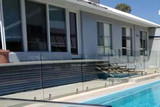Australian Pool Fence Laws
Australian pool fence laws and regulations are a combination of Australian Standards and state laws, but it's vital that you know your local laws. Find the details for your state in our handy guide.
Having a swimming pool in the backyard can be so rewarding and can provide you and your family with an amazing source of fun, entertainment and exercise. However, unsecured swimming pools and unsupervised children are a terrible combination with heartbreaking consequences. If you're working with a licensed, reputable builder or pool construction company, your qualified professional will be able to advise on exactly what type of pool fencing you need to ensure you're complying with Australian and state laws. If you're installing your own pool fence, do your homework now and save yourself a whole lot of heartbreak and money down the track. Pool fencing regulations in Australia are a combination of national standards and state laws and because of the tragic statistics involving drowning related deaths in Australia, the penalties for not being up to standard are severe.
Australian Standard AS1926.1-2012: Safety Barriers for Swimming Pools
Australian Standard AS1926.1-2012 is the current national standard governing pool fences in New South Wales, Victoria, South Australia, Tasmania, Western Australia and the ACT. There are previous versions of the standard for pools built between certain dates, but AS1926.1-2012 is the relevant standard for all new pools. It's also important to note that while the national standard applies to pool fences throughout Australia, state governments have established laws and procedures to regulate pool fence compliance in their respective states.
Australian Standard AS1926.1-2012 applies to all pools, including inflatable pools and spa pools as well as in-ground or above ground pools.
Inflatable Pools
While inflatable pools under 300mm in height do not currently require a fence, they do require three specific warning labels:
- Pool owners, parents and carers need to be aware of the potential for drowning even in shallow water. You should always supervise children when they are using these products.
- Ensure that the water is kept pure. Water left in inflatable pools for periods of time can become contaminated and cause illness.
- Empty the pool and store it safely (away from young children) when it is not in use.
Inflatable pools 300mm or more in height require the above warning labels and are subject to relevant pool fence laws.
Spa Pools
If your spa pool does not have a securely fastened, child-resistant structure (such as a door, lid, grille or mesh) blocking access to the spa when not being used, your must have a fence to restrict access to the spa area.
General Pool Fence Requirements
Here are some of the key requirements for pool fences set out in the Australian Standard. A pool fence must:
- be at least 1.2m high (as measured from the finished ground level)
- not leave a gap at the bottom bigger than 10cm from the finished ground level
- if a boundary fence is part of the pool fence, the barrier must be 1.8m high
- pool owners must maintain a 'non-climbable' zone around the pool
- doors in pool barriers swing outwards (away from the pool area) and must close without the application of manual force
- doors in pool barriers must self-latch and require manual release
- the standard requires that you have a cardiopulmonary resuscitation (CPR) sign displayed near the pool. The sign must be in good condition and able to be read easily from 3 metres
NSW Pool Fence Laws
All pools (including cheap blow up pools) built in NSW after 1 September 2018 are subject to the Swimming Pools Act 1992 and legislated by Swimming Pools Regulation 2018 .
Pool fences in NSW must comply with the performance requirements set out in the Building Code of Australia and must be inspected by licensed inspectors and registered with the NSW Government Swimming Pool Register. See the Pool Fencing Requirements page of the NSW Fair Trading website for more detailed information.
Victoria Pool Fence Laws
New laws were introduced on 1 December 2019 to improve swimming pool and spa safety in Victoria. They include new registration, inspection and certification requirements for property owners. All swimming pools and spas capable of containing water greater than 300mm (30cm) must have a compliant safety barrier to restrict access to the pool area by young children (under the age of five). There are three separate checklists for barrier standards, depending on when your pool or spa was installed:
- Checklist 1 (for pools and spas installed before 8 April 1991)
- Checklist 2 (for pools and spas installed between 8 April 1991 and 30 April 2010)
- Checklist 3 (for pools and spas installed from 1 May 2010)
With the introduction of the new laws in 2019, owners are required to register their pool and spa with their local council and have their safety barrier inspected once every four years. You can view the new laws and other relevant information on the Victorian Building Authority website .
Queensland Pool Fence Laws
Queensland pool fence laws and regulations are overseen by the Queensland Building and Construction Commission and property owners are required to register their pool with the QBCC. The standard applies to new or existing pools for houses (both short and long term accommodations), unit complexes, hotels, motels, backpacker accommodation, caravan parks and mobile van parks.
The QBCC provides a handy, interactive pool compliance checklist for property owners to ensure that their pool and fence or barrier is compliant with Australian and Queensland laws and regulations. The QBCC does emphasise that their checklist tool is a guide only and not an approval or acknowledgement of compliance and always recommend that you engage a licensed pool safety inspector to confirm that your pool is compliant.
South Australia Pool Fence Laws
Pool fence laws in South Australia are covered by the Swimming Pools (Safety) Act 1972 and the Development Act 1993 . In South Australia, only council officers have legislative authority under the Development Act 1993 to enforce requirements for swimming pool and spa pool safety.
South Australia have different laws and regulations for pools built after certain dates, meaning the laws that apply to your pool may differ from the laws that apply to someone's else pool. Check the South Australian Government website for specific information about pool fencing laws and regulations in South Australia ..
Since 1 April 2014, all new swimming and spa pools must be inspected by the council within two months of the completion of the permanent, approved child-safety barriers. For more information on South Australian pool fence inspection requirements, check the Advisory Notice 07/16 Building Code of Australia 2016 .
Tasmania Pool Fence Laws
All new domestic pool and spa safety barriers must adhere to Part 3.9.3 of the Building Code of Australia (BCA) Volume 2 'Swimming Pool Access' and all swimming pools or spas that hold a depth of water of 300mm or more that were installed from 1994 onward must install a pool safety barrier.
For pools installed before 1994, installation and maintenance of pool safety barriers are strongly recommended. You can find more information about pool fence laws in Tasmania on the Tasmanian Government Consumer, Building and Occupational Services website and the Staying safe around pools and spas fact sheet.
Western Australia Pool Fence Laws
The design, construction and installation of private swimming and spa pools and their safety barriers is regulated by the Building Act 2011 (the Act) and the Building Regulations 2012 (the Regulations) and is overseen by the Western Australia Department of Mines, Industry Regulation and Safety (formerly known as the Western Australia Department of Commerce).
Under the Act, a building permit is required prior to installing, constructing, or altering swimming and spa pool barriers, including windows, doors and gates that restrict access to a swimming or spa pool area. A building permit is also required for the construction of swimming and spa pools.
Western Australia has specific barrier compliance regulations for pools built post-May 2016 after the state adopted the Building Code of Australia (BCA) 2016 provisions, however there is currently no retrospective requirement for owners to upgrade existing barriers for pre-May 2016 pools, provided that they are compliant with pre-May 2016 barrier regulations. For more information on Western Australia pool fence laws, see the Rules for Pools and Spas guide from the Western Australia Department of Mines, Industry Regulation and Safety.
ACT Pool Fence Laws
Pool and spa fencing in the ACT must adhere to Australian Standard AS1926-2012 (the standard) and barriers must be certified as compliant with the Building Act 2004, by an ACT licensed building surveyor otherwise known as a building certifier.
Pool and spa owners that have an existing boundary fence as part of their pool and spa fence may need to install a separate safety fence, as boundary fences can become ineffective safety barriers over time, causing a pool or spa barrier to fail compliance.
For older or pre-existing pools and spas that were lawfully constructed in the ACT, there is no specific requirements to upgrade the relevant barrier as long as the barrier has not been altered or relocated since installation. Any alterations must comply with the Building Act 2004. Visit the Access Canberra website for more information on ACT pool fence laws and regulations .
Northern Territory Pool Fence Laws
Pool safety barriers in NT are regulated by the Swimming Pool Safety Act 2004 and are based on the Modified Australian Standard , however, different standards and certification requirements apply depending on when the pool was installed and if the property has previously been sold, transferred or leased. Pool fencing safety standards apply to residential properties including houses, units, townhouses and caravans and mobile homes in a caravan park and there are different standards depending on when your pool was built, how big your property is and if you rent or own your property.
The important factors that determine which laws and standards apply to you are:
- whether your pool or spa was installed before or after 1 January 2003
- whether your residential property is more or less than 1.8 hectares in size
- whether your property has been sold or leased by any owner since 1 January 2003
You can contact the Pool Fencing Unit for a free advice inspection by a pool safety adviser, or visit the NT Government website for more information on NT pool fencing laws .
Check with your State and Local Authorities
While most states & territories adhere to the same Australian Standards, there are minor differences in how these standards are applied at state and local council level.
If you're interested in replacing an existing pool or spa barrier or are having a new pool or spa installed, always check with your relevant state authority, your local council or a licensed builder to ensure your pool or spa and it's barrier is safe and compliant. You can find your local council’s details on the Australian Local Government Association’s website.
If you need any help with planning your fence, give the friendly team at Fence Guru a call! We love helping our customers plan their projects and help them buy the right equipment at the best price.
Recent Posts
-
Polaris Soft Close Hinges - Are They Worth The Extra Cost?
Fence Guru offers a high quality range of frameless glass pool fencing, with all the necessary hardw …13th May 2021 -
Choosing Your Spigot Finish For a Frameless Glass Pool Fence - Satin or Polished?
We often get asked by customers as to whether they should purchase our polished or satin stainless s …28th Apr 2021 -
Australian Pool Fence Laws
Australian pool fence laws and regulations are a combination of Australian Standards and state la …1st Jun 2020





